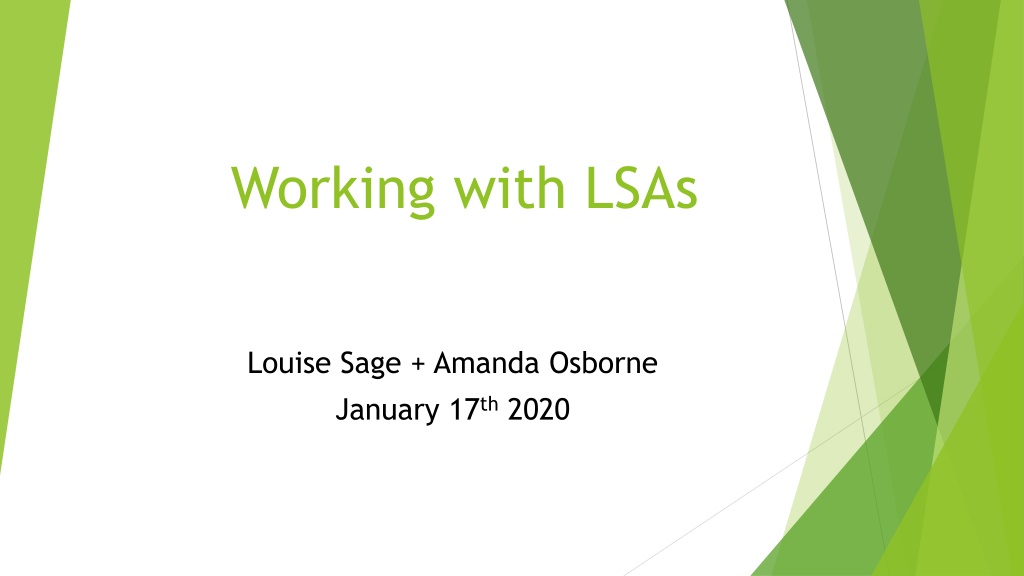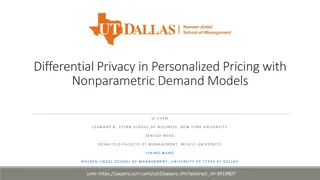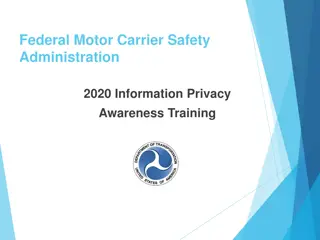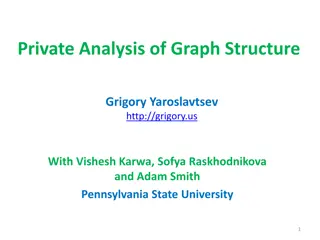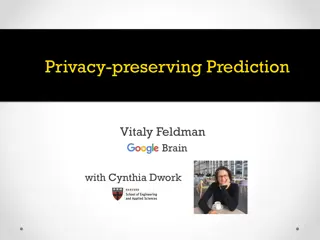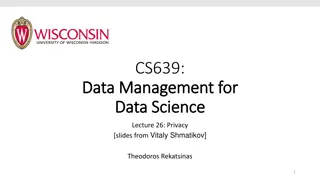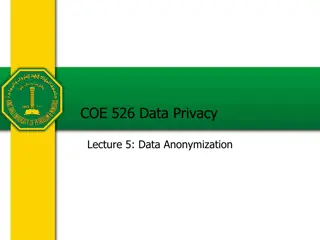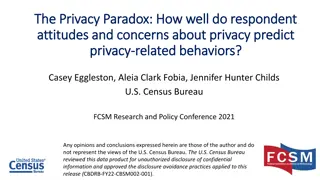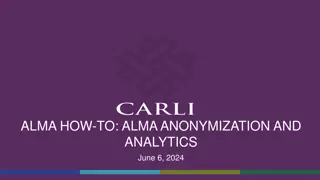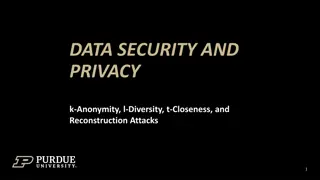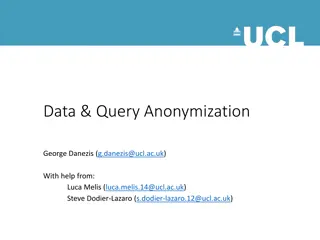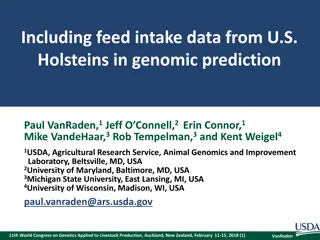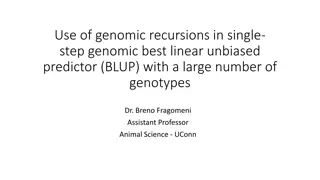Privacy Preserving Genomic Data Anonymization
This study introduces a novel haplotype-based noise-adding approach for anonymizing genomic data to mitigate re-identification risks. Differential privacy concepts and naive algorithms are applied to ensure the protection of sensitive genetic information in human genomic datasets, particularly in the context of genome-wide association studies. Results show the effectiveness of this method in maintaining privacy while preserving data utility for genetic marker discovery.
Download Presentation

Please find below an Image/Link to download the presentation.
The content on the website is provided AS IS for your information and personal use only. It may not be sold, licensed, or shared on other websites without obtaining consent from the author.If you encounter any issues during the download, it is possible that the publisher has removed the file from their server.
You are allowed to download the files provided on this website for personal or commercial use, subject to the condition that they are used lawfully. All files are the property of their respective owners.
The content on the website is provided AS IS for your information and personal use only. It may not be sold, licensed, or shared on other websites without obtaining consent from the author.
E N D
Presentation Transcript
Working with LSAs Louise Sage + Amanda Osborne January 17th2020
Aims: By the end of today s session you will have more awareness of how to work effectively with LSAs, linked to Standard 8. Develop effective professional relationships with colleagues, focusing on how: to deploy support staff effectively to improve adult interactions with pupils and the principles behind effective classroom talk additional adults can scaffold pupils learning and feedback pupils learning effectively to teachers
Research The Deployment and Impact of Support Staff (DISS) Project Largest study of teaching assistants and other school support staff carried out in the world. Conducted between 2003 and 2009, was named by the British Educational Research Association as one of 40 landmark studies to have had a significant impact on education in last 40 years. First longitudinal study to analyse the impact of TAs on teachers, teaching and pupils' learning, behaviour and academic progress in everyday classroom settings. The findings have been widely reported in the media and have important implications for teaching, school management and the education of pupils - especially those with special educational needs.
Results: They found that there was a negative relationship between the amount of TA support received and the progress made by pupils in mainstream primary and secondary schools. It is the way schools and teachers deploy and prepare TAs factors that are out of TAs control that best explain the surprising results. The more support pupils received from support staff, the less progress they made (a consistent negative relationship between the amount of support pupils received and their progress in maths, science and English). TAs were more focused on completing tasks than pupils' learning and understanding. Support staff allowed for teachers to spend more one-to-one time with pupils, reduced their workload and stress levels, and increased job satisfaction.
Explanation of results: TAs support pupils who make least progress anyway ? Analysis controlled for factors affecting attainment Organisational factors out of TAs control Positive impact on teacher workloads & stress Not necessarily the fault of the TAs!
Effective Deployment of Teaching Assistants (EDTA) To address the practical issues raised by the DISS project, the EDTA action research project was conducted over the 2010/11 school year. As a result of participating in the intervention, they found that teachers were more aware of their responsibilities towards lower- attaining pupils and those with SEN; worked more often with these pupils and they provided TAs with clearer and more detailed lesson plans. There were also improvements in the quality of TAs interactions with pupils, and a consequent increase in TAs self esteem and confidence as a result of having a more clearly defined role in the classroom.
Outcomes: Preparedness - creating time for teachers and TAs to meet had a positive effect on the quality of TA input and helped make their roles more explicit Deployment - senior leadership teams, as well as teachers thought more strategically about the role and purpose of TAs and expected outcomes for pupils, and how they could add value to teachers Practice - TAs roles developed to support pupils' learning and assessment.
Making a Statement Project (MaST) Over 2011/12, this project carried out minute-by-minute observations on 48 pupils in Year 5 who had Statements and interviewed 200 school staff and parents. Outcomes showed: Pupils in mainstream schools with SEN statements spent over a quarter of their time away from the mainstream class, the teacher and their peers compared to other pupils. TAs had more responsibility for pupils with SEN statements than teachers - curricula, lesson planning, moment-to-moment teaching and learning decisions. The quality of pedagogical experiences was less appropriate and of a lower quality than for other pupils. Gaps were found in the knowledge of both teachers and TAs in meeting the needs of pupils with statements - teachers felt unprepared and often saw TAs as experts despite similar gaps in training and knowledge.
Key Publications Anthony Russell, Peter Blatchford and Rob Webster, 2013 Education Endowment Fund March 2015 Paula Bosanquet,Julie Radford and Rob Webster 2015
SEN code of practice (DfE 2014) The teacher is responsible and accountable for the progress and development of the pupils in their class, including where pupils access support from TAs or specialist staff. A teacher s responsibility is to know the levels of development of all of the pupils, to assess their progress and to ensure that the curriculum is accessible to pupils with SEN by differentiating tasks. This is done with the support of the SENCo (not by the SENCo).
Preparedness How prepared are TAs to fulfil their day-to-day learning support role? Deployment How are the TAs used in the classroom? How would you like to use them? TAs tend to work with the less able Teachers tend to work more at whole class level Pupils with SEN were found to receive more pedagogical input from a TA than their teacher What is the role of the TA in your classroom? Research found 3 common occurring characteristics in TA interactions with pupils: Practice What impact does the TA have on pupils progress? How does he/she ensure pupils are learning? Focus on end product/ task completion Less link to learning aims Open/ Closed questioning
How can we prepare TAs for their role? Planning Feedback CPD
Assessment for Learning Pupils need to know the goal they are working on for each part of a task Pupils need specific feedback on that goal as they work When pupils are overwhelmed, focusing on one Process Success Criteria at a time helps Positive experiences provide the momentum to continue or try again
Feedback from TAs A TA is working with a group of pupils on a science task. She has been asked to keep the following feedback record which she completes as she goes along. What does the teacher know about the progress of the children in this task? Name Process Success Criteria Ragu Samina Lesley Rizwan Say what you think will happen e.g. I think the lithium will fizz Give at least one reason why I think this e.g. It reacts with water Give relevant evidence to support the prediction e.g. It is close to potassium in the periodic table
What does the teacher know about the progress of the children in this task now? Key: Can do this independently P Can do with a prompt C can do with a clue M Modelled for the child Name Process Success Criteria Ragu Samina Lesley Rizwan Say what you think will happen e.g. I think the lithium will fizz P Give at least one reason why I think this e.g. It reacts with water P P P Give relevant evidence to support the prediction e.g. It is close to potassium in the periodic table C M C M
A FRAMEWORK FOR SCAFFOLDING LEARNING Recognising a task as a series of smaller learning goals Carefully observing the progress of the pupils as they complete each part of a task Only intervening if the pupil has not been able to overcome a difficulty independently Giving specific feedback or help when a pupil needs help with a part of the task Providing the minimal amount of help needed to achieve The TA role is to help pupils know what to do when they don t know what to do! Lev Vygotsky (1896 1934).
Scaffolding will lead to: Greater independence Ability to cope with learning challenges and setbacks Developing a relationship with failure A deeper engagement in and appreciation of learning for learning s sake Accessing the teacher for support when needed Greater opportunities for peer interaction Less risk of stigmatisation THIS WILL TAKE TIME! The more dependent a child is on adult support the longer it will take.
Scaffolding Framework Start at the top with the expectation that a child will self-scaffold Intervene at the point a child has a difficulty that they can t overcome by themselves PROVIDE THE LEAST AMOUNT OF HELP FIRST
Self-scaffolding-The ability to be able to work through tasks independently, using strategies pupils have previously learned. The role of the adult is minimal Listen and tune in to check that the strategies a child is using are effective Get familiar with the signs that intervention maybe needed but... FIGHT THE URGE TO JUMP IN Self Scaffolding involves: Planning how to approach a task Problem solving during a task Reviewing success of a task and strategies employed
Prompting If a child can t understand or do a task they can t self scaffold If a task has been planned within the ZPD there must a starting point within their prior knowledge But this may need teasing out .... e.g. a prompt
There are 3 types of prompt: Say nothing Verbal prompt Gesture Prompting- Prompting is an action designed to encourage the pupil to draw on prior learning 1. Say nothing TA: What are icicles? P: They re ice that ...... They re ice that, um (mimes) TA: (5 second pause) P: Hangdown 2. Verbal Prompt You have a think about what to do next What do you think you could do? What is your plan? Can you remember what your teacher said? How could you work it out? 3. Gesture When a child is unable to find a word give them thinking time (3 to 5 seconds) Point, tap, indicate something that might help But don t point to the answer
Clueing Gives pupils a piece of information or a hint that will help them to work out work to do Research says that TAs tend to give a clue too quickly A good way to give a clue is to use a question
Clueing Clueing is harder than prompting because it requires making quick decisions in the moment Clues depend on the task and specifically which bit a child is stuck on Rather than telling a child use a questions which points them in the right direction
Modelling Demonstrating how to do the part of a task the pupil is unable to do, (or to improve quality or to provide challenge).
Modelling Golden Rules: Use modelling techniques if you are sure the task is something the pupil can t attempt without prompting or clueing Use when a pupil has done or said something incorrectly and is unaware of their error Short clear modelling works best Pupils must be actively listening Pupils need to try it for themselves as soon as possible after modelling
Correcting Giving the answer or telling a child how to do something This is giving the most amount of help first
So how can we use an extra adult effectively within a lesson?
